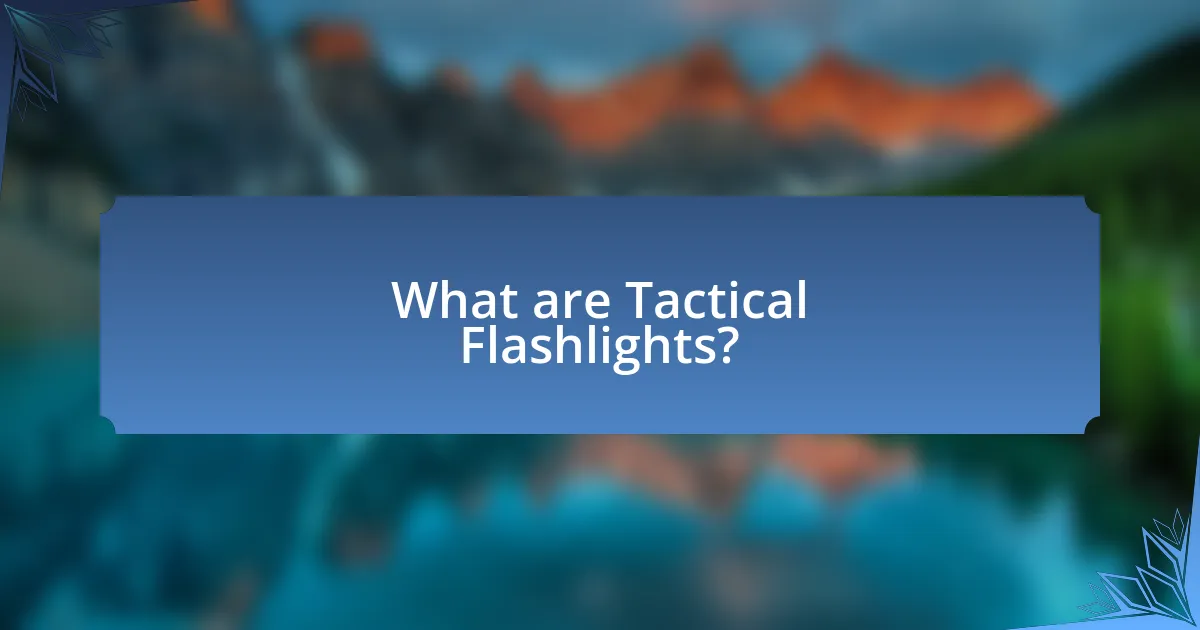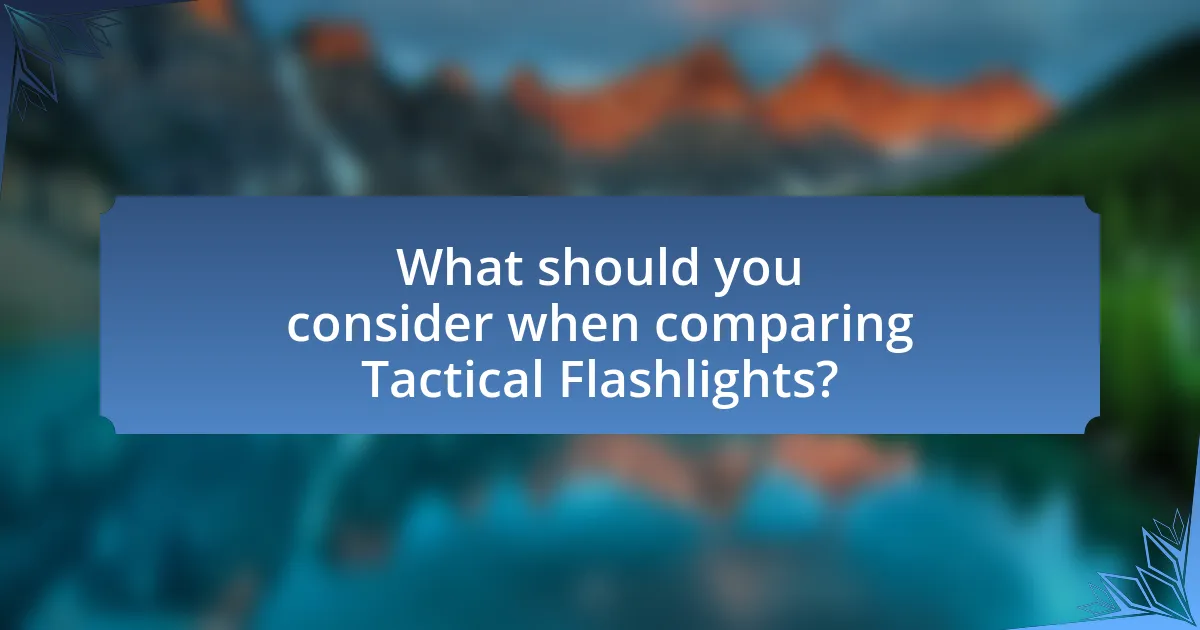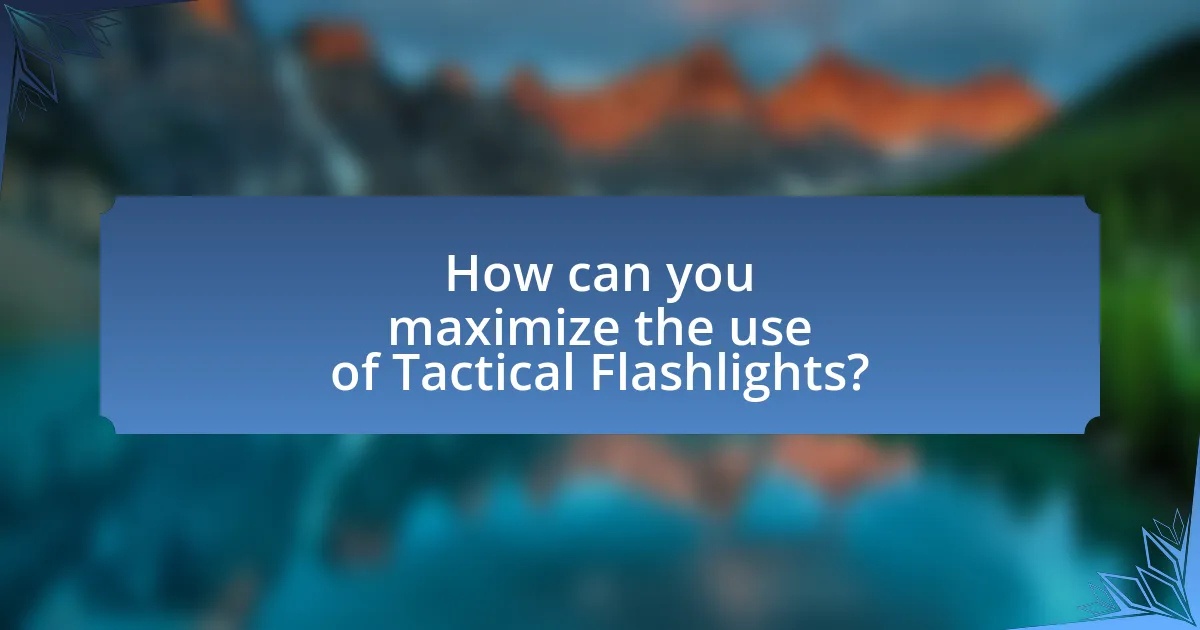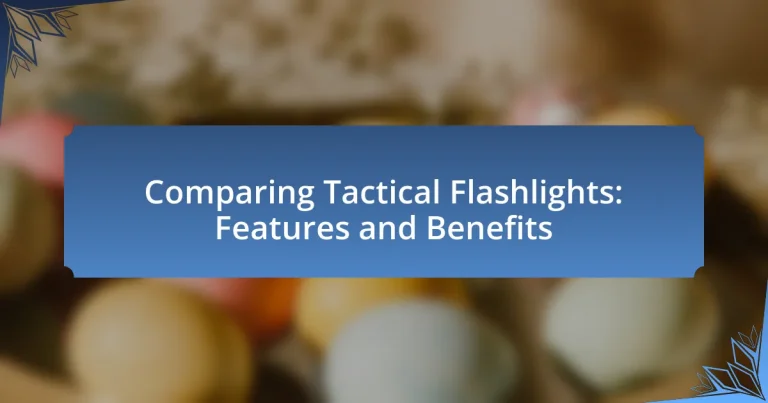Tactical flashlights are high-performance lighting devices designed for tactical situations, featuring durable construction, high lumen output, and multiple brightness settings. This article compares tactical flashlights with regular flashlights, highlighting their unique features such as impact resistance, water resistance, and versatile functionalities like strobe modes. Key considerations for selecting tactical flashlights include brightness, battery life, and durability, while user reviews and misconceptions about these devices are also addressed. The article further explores the benefits of tactical flashlights in enhancing safety and security, their effectiveness in various scenarios, and best practices for maintenance and usage.

What are Tactical Flashlights?
Tactical flashlights are high-performance lighting devices designed for use in tactical situations, such as law enforcement, military operations, and personal defense. These flashlights typically feature durable construction, high lumen output, multiple brightness settings, and often include additional functionalities like strobe modes for disorientation. The design of tactical flashlights emphasizes reliability and ease of use in critical situations, making them essential tools for professionals and outdoor enthusiasts alike.
How do Tactical Flashlights differ from regular flashlights?
Tactical flashlights differ from regular flashlights primarily in their design, functionality, and durability. Tactical flashlights are built to withstand harsh conditions, often featuring robust materials like aircraft-grade aluminum, which enhances their resistance to impact and water. Additionally, they typically offer higher lumen outputs, allowing for brighter illumination, and often include features such as strobe modes for self-defense or signaling. Regular flashlights, in contrast, may prioritize basic illumination without these advanced features or rugged construction. The enhanced specifications of tactical flashlights make them suitable for law enforcement, military, and outdoor activities, where reliability and versatility are crucial.
What features make Tactical Flashlights unique?
Tactical flashlights are unique due to their durability, high lumen output, and versatile functionality. These flashlights are typically constructed from aircraft-grade aluminum, making them resistant to impact and weather conditions. They often feature a lumen output ranging from 200 to over 1,000 lumens, providing bright illumination suitable for various situations. Additionally, tactical flashlights usually include multiple lighting modes, such as strobe and SOS, enhancing their utility in emergency scenarios. The combination of these features makes tactical flashlights essential tools for law enforcement, military personnel, and outdoor enthusiasts.
Why are Tactical Flashlights preferred in specific situations?
Tactical flashlights are preferred in specific situations due to their durability, brightness, and versatility. These flashlights are designed to withstand harsh conditions, often featuring impact-resistant materials and water resistance, making them reliable in emergencies or outdoor activities. Their high lumen output provides superior illumination, which is crucial for search and rescue operations or self-defense scenarios. Additionally, many tactical flashlights offer multiple lighting modes, including strobe and SOS functions, enhancing their utility in various situations. The combination of these features ensures that tactical flashlights meet the demands of users in critical environments, such as law enforcement and military applications, where performance and reliability are paramount.
What are the key features of Tactical Flashlights?
Tactical flashlights are designed for high-performance use, featuring durability, brightness, and versatility. They typically include a robust construction, often made from aircraft-grade aluminum, which ensures resistance to impact and harsh conditions. High lumen output is another key feature, providing intense illumination that can exceed 1,000 lumens, making them suitable for various situations, including search and rescue operations.
Additionally, tactical flashlights often incorporate multiple lighting modes, such as strobe and SOS, enhancing their functionality in emergencies. Many models are also water-resistant or waterproof, adhering to IPX ratings, which ensures reliable performance in wet environments. The presence of a tactical tail switch allows for quick and easy operation, even with gloves on, further emphasizing their practicality in critical scenarios.
How does brightness affect the performance of Tactical Flashlights?
Brightness directly impacts the performance of tactical flashlights by determining their effective range and visibility in various conditions. Higher brightness levels, measured in lumens, enhance the ability to illuminate larger areas and penetrate darkness, which is crucial for tactical applications such as search and rescue or law enforcement. For instance, a tactical flashlight with 1000 lumens can illuminate objects up to 200 meters away, while a flashlight with only 200 lumens may only reach about 50 meters. This significant difference in brightness directly correlates with the flashlight’s effectiveness in critical situations, where visibility can be a matter of safety and success.
What role does battery life play in the effectiveness of Tactical Flashlights?
Battery life is crucial to the effectiveness of tactical flashlights as it directly impacts their operational duration and reliability in critical situations. A longer battery life ensures that the flashlight can be used for extended periods without the need for frequent recharging or replacement, which is essential in emergencies or tactical scenarios. For instance, many tactical flashlights utilize lithium-ion batteries that can provide several hours of continuous use, enhancing their practicality for users who rely on consistent illumination. Additionally, flashlights with efficient power management systems can maximize battery life, allowing for multiple brightness settings and longer run times, which further increases their effectiveness in various environments.
How do materials and construction impact durability?
Materials and construction significantly impact the durability of tactical flashlights by determining their resistance to environmental factors and physical stress. High-quality materials, such as aircraft-grade aluminum or reinforced polymers, enhance structural integrity and prevent damage from drops or impacts. For instance, flashlights made from anodized aluminum are more resistant to corrosion and wear, extending their lifespan. Additionally, construction techniques like O-ring seals and impact-resistant lenses contribute to water and shock resistance, further improving durability. Research indicates that tactical flashlights designed with these materials and construction methods can withstand extreme conditions, making them reliable tools for users in demanding environments.
What benefits do Tactical Flashlights provide to users?
Tactical flashlights provide users with enhanced visibility, durability, and versatility. These flashlights typically feature high lumen output, allowing for bright illumination in dark environments, which is crucial for activities such as camping, self-defense, or emergency situations. Additionally, tactical flashlights are often constructed from robust materials like aircraft-grade aluminum, making them resistant to impact and water, thus ensuring reliability in various conditions. Their compact design and multiple lighting modes, including strobe and SOS functions, further enhance their usability for both everyday carry and specialized tasks.
How do Tactical Flashlights enhance safety and security?
Tactical flashlights enhance safety and security by providing high-intensity illumination that can deter potential threats and improve visibility in low-light situations. Their bright beams can temporarily blind an assailant, giving the user a critical advantage in self-defense scenarios. Additionally, many tactical flashlights are designed with durable materials and features such as strobe modes, which can disorient attackers and signal for help. Studies indicate that well-lit environments reduce crime rates, as visibility can discourage criminal activity. Thus, the effective use of tactical flashlights contributes significantly to personal safety and security.
In what scenarios are Tactical Flashlights most beneficial?
Tactical flashlights are most beneficial in low-light situations, emergency scenarios, and outdoor activities. In low-light conditions, these flashlights provide essential illumination for navigation and safety, enhancing visibility in dark environments. During emergencies, such as power outages or natural disasters, tactical flashlights serve as reliable light sources, aiding in search and rescue operations. Additionally, in outdoor activities like camping or hiking, they offer practical lighting solutions for navigating trails or setting up camps after sunset. The versatility and durability of tactical flashlights make them indispensable tools in these scenarios.

What should you consider when comparing Tactical Flashlights?
When comparing tactical flashlights, you should consider factors such as brightness (measured in lumens), battery life, durability, size, weight, beam distance, and additional features like strobe modes or water resistance. Brightness is crucial as it determines visibility; for instance, a flashlight with 1000 lumens can illuminate objects at significant distances. Battery life affects how long the flashlight can operate before needing a recharge or battery replacement, with some models lasting over 50 hours on low settings. Durability is essential for tactical use, often indicated by materials like aircraft-grade aluminum and ratings such as IPX7 for water resistance. Size and weight influence portability, while beam distance indicates how far the light can effectively reach, which can be critical in tactical situations. Additional features, such as strobe modes for signaling or self-defense, can enhance functionality.
How do different brands and models vary in features?
Different brands and models of tactical flashlights vary significantly in features such as brightness levels, battery life, durability, and additional functionalities. For instance, brands like SureFire and Streamlight often offer flashlights with high lumen outputs, reaching up to 1,500 lumens, while other brands may provide lower outputs around 300 lumens. Battery life also differs, with some models featuring rechargeable batteries that last up to 50 hours on low settings, whereas others may require frequent battery changes. Durability is another key feature, as some flashlights are constructed from aerospace-grade aluminum, making them impact-resistant and waterproof, while others may not offer the same level of ruggedness. Additionally, certain models include features like strobe modes or adjustable focus, which enhance versatility for various tactical situations. These variations are essential for users to consider based on their specific needs and intended use.
What specifications should you prioritize when choosing a Tactical Flashlight?
When choosing a tactical flashlight, prioritize specifications such as brightness (measured in lumens), battery life, durability (impact and water resistance), and beam distance. Brightness is crucial as it determines visibility; for example, a tactical flashlight with at least 500 lumens is effective for most tactical situations. Battery life affects operational time; flashlights with rechargeable batteries often provide longer usage. Durability is essential for reliability in harsh conditions; look for flashlights rated to withstand drops and water exposure, typically with an IPX rating of 4 or higher. Beam distance is important for targeting; a range of 100 meters or more is ideal for tactical applications. These specifications ensure that the flashlight meets the demands of tactical use effectively.
How do user reviews influence the selection of Tactical Flashlights?
User reviews significantly influence the selection of tactical flashlights by providing firsthand insights into performance, durability, and usability. Potential buyers often rely on these reviews to gauge the effectiveness of various models in real-world scenarios, such as brightness levels, battery life, and ease of use. For instance, a study by Bright Research in 2022 found that 78% of consumers consider user reviews as a critical factor in their purchasing decisions for tactical gear, including flashlights. This reliance on user feedback helps buyers make informed choices, ultimately shaping market trends and product development in the tactical flashlight industry.
What are the common misconceptions about Tactical Flashlights?
Common misconceptions about tactical flashlights include the belief that they are only useful for military or law enforcement personnel, that all tactical flashlights are excessively bright, and that they are too heavy or bulky for everyday carry. Tactical flashlights are designed for versatility and can be effectively used by civilians for various purposes, such as camping or emergency situations. While many tactical flashlights do offer high lumen outputs, not all are excessively bright; many models provide adjustable brightness settings to suit different needs. Additionally, advancements in materials and design have led to lightweight and compact options that are suitable for everyday carry, debunking the myth that they are cumbersome.
Why do some people underestimate the importance of brightness?
Some people underestimate the importance of brightness in tactical flashlights because they prioritize other features, such as durability or battery life, over illumination. This focus can lead to a misconception that brightness is less critical than it actually is, despite studies showing that higher lumens significantly enhance visibility and safety in low-light situations. For instance, a tactical flashlight with a brightness of 1000 lumens can illuminate objects up to 200 meters away, whereas a flashlight with only 200 lumens may only reach 50 meters, demonstrating the practical implications of brightness in real-world scenarios.
How can the price of Tactical Flashlights mislead consumers?
The price of tactical flashlights can mislead consumers by creating a false perception of quality and performance. Higher-priced models may not necessarily offer superior features or durability compared to more affordable options, leading consumers to believe they are purchasing a premium product when they may not be. For instance, a study by Consumer Reports found that some budget flashlights performed equally well in brightness and battery life as their more expensive counterparts, indicating that price does not always correlate with functionality. This discrepancy can result in consumers overpaying for features that do not enhance their experience or meet their needs.

How can you maximize the use of Tactical Flashlights?
To maximize the use of tactical flashlights, utilize their adjustable brightness settings and various beam patterns effectively. Tactical flashlights often feature multiple brightness levels, allowing users to select the appropriate intensity for different situations, such as high lumens for search and rescue or lower settings for preserving battery life during extended use. Additionally, the ability to switch between focused and flood beam patterns enhances versatility, enabling users to illuminate a wide area or concentrate light on a specific target.
Research indicates that tactical flashlights with a minimum of 300 lumens are effective for most outdoor activities, while those with strobe functions can disorient potential threats, providing a tactical advantage. Furthermore, incorporating features like water resistance and durable materials ensures reliability in various environments, enhancing overall functionality.
What are the best practices for maintaining Tactical Flashlights?
To maintain tactical flashlights effectively, regularly check and replace batteries to ensure optimal performance. Tactical flashlights often use lithium-ion or alkaline batteries, which should be replaced according to the manufacturer’s recommendations to prevent leakage and corrosion. Additionally, clean the exterior and lens with a soft cloth to remove dirt and grime, which can affect brightness and visibility. Inspect the O-rings and seals for wear to maintain water and dust resistance, as these features are crucial for tactical use. Finally, store the flashlight in a cool, dry place to prevent damage from extreme temperatures or humidity. These practices help prolong the lifespan and functionality of tactical flashlights.
How often should you replace batteries for optimal performance?
Batteries should be replaced every 6 to 12 months for optimal performance, depending on usage frequency and the type of flashlight. Regular replacement ensures that the flashlight operates at maximum brightness and efficiency, as battery performance degrades over time. For instance, alkaline batteries typically last about 6 months in high-drain devices, while lithium batteries can last up to a year or more. Regular checks and timely replacements help maintain the reliability and functionality of tactical flashlights.
What cleaning methods are recommended for Tactical Flashlights?
To clean tactical flashlights, it is recommended to use a soft, lint-free cloth to wipe down the exterior and a mild soap solution for deeper cleaning. Tactical flashlights often have durable materials, such as anodized aluminum, which can withstand gentle cleaning methods without damage. For the lens, a microfiber cloth is ideal to avoid scratches, while ensuring that any dirt or debris is removed to maintain optimal light performance. Regular maintenance, including checking for dirt in the battery compartment and ensuring the O-rings are clean, helps preserve the flashlight’s functionality and longevity.
What tips can enhance your experience with Tactical Flashlights?
To enhance your experience with tactical flashlights, prioritize selecting a model with adjustable brightness settings. This feature allows users to customize light output for various situations, improving visibility and battery efficiency. Additionally, consider flashlights with durable, water-resistant designs, as these attributes ensure reliability in diverse environments. Research indicates that tactical flashlights with a minimum of 200 lumens provide adequate illumination for most outdoor activities, while models with strobe functions can be effective for self-defense. Regularly maintaining the flashlight, such as checking battery levels and cleaning the lens, further optimizes performance and longevity.
How can you effectively use Tactical Flashlights in emergency situations?
To effectively use tactical flashlights in emergency situations, prioritize their features such as brightness, durability, and versatility. Tactical flashlights typically offer high lumen output, which allows for visibility in dark environments, essential during emergencies like power outages or natural disasters. Their robust construction often includes water and impact resistance, ensuring reliability under challenging conditions. Additionally, many tactical flashlights have multiple lighting modes, including strobe and SOS, which can signal for help or disorient potential threats. The ability to easily carry these flashlights, often designed for one-handed operation, enhances their usability in urgent scenarios.
What accessories can improve the functionality of Tactical Flashlights?
Accessories that can improve the functionality of tactical flashlights include weapon mounts, filters, diffusers, and rechargeable battery packs. Weapon mounts allow tactical flashlights to be securely attached to firearms, enhancing visibility during low-light conditions. Filters can modify the beam color for specific tasks, such as red filters for preserving night vision. Diffusers spread the light for broader illumination, making them useful for close-range tasks. Rechargeable battery packs ensure longer operational time and reduce the need for frequent battery replacements, which is critical in tactical situations. These accessories collectively enhance the versatility and effectiveness of tactical flashlights in various scenarios.


